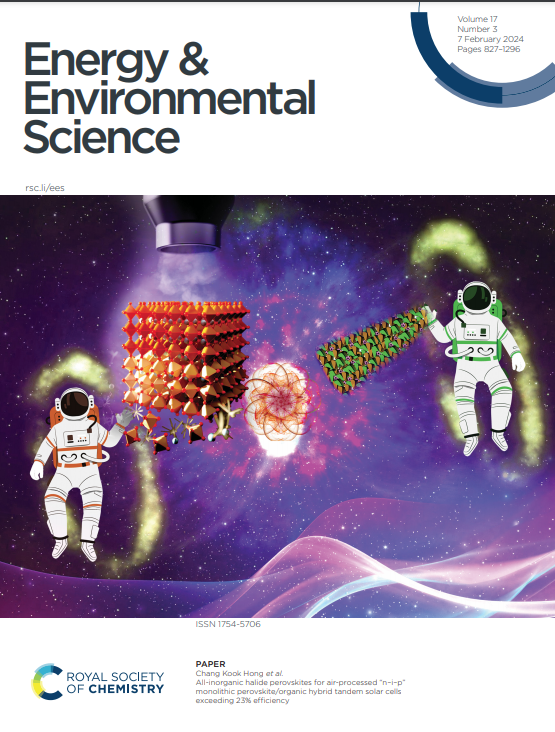Advancing high-temperature electrostatic energy storage via linker engineering of metal–organic frameworks in polymer nanocomposites
IF 32.4
1区 材料科学
Q1 CHEMISTRY, MULTIDISCIPLINARY
引用次数: 0
Abstract
High-performance, thermally resilient polymer dielectrics are essential for film capacitors used in advanced electronic devices and renewable energy systems, particularly at elevated temperatures where conventional polymers fail to perform. Compositing polymers with nanofillers is a well-established approach to enhancing energy storage performance, though there remains a strong need for fillers with broad structural tunability and a clear structure-property relationship to further improve performance at elevated temperatures. Herein, we unravel the untapped potential of UiO-66 metal–organic framework (MOF) derivatives as exceptional nanofillers for tuning the properties of the widely used polyetherimide (PEI). By systematically varying the linker structures, we create a series of isostructural MOF fillers that exhibit contrasting capabilities in regulating the charge transport and energy storage capacities of the resulting composite films. Notably, capacitors based on composite films using the electron-deficient UiO-66-F4 show remarkable long-term charge-discharge stability and achieve ultrahigh discharged energy densities of 9.87 J cm−3 at 150 °C and 9.21 J cm−3 at 200 °C, setting a new benchmark for high-temperature flexible polymer composites. Through comprehensive experimental and theoretical analyses, we establish an unprecedented correlation between the MOF fillers' electronic structures and the composites’ improved electrical breakdown strength and energy storage properties. These findings offer a rational pathway to harness the exceptional structural diversity of MOFs for the development of composite materials suitable for high-temperature electrostatic energy storage.通过聚合物纳米复合材料中金属有机框架的链接工程推进高温静电储能
高性能、热弹性聚合物电介质对于先进电子设备和可再生能源系统中使用的薄膜电容器至关重要,尤其是在传统聚合物无法发挥性能的高温条件下。将聚合物与纳米填料复合是提高储能性能的一种行之有效的方法,但目前仍亟需具有广泛结构可调性和明确结构-性能关系的填料,以进一步提高高温下的性能。在此,我们揭示了 UiO-66 金属有机框架 (MOF) 衍生物作为特殊纳米填料在调整广泛使用的聚醚酰亚胺 (PEI) 性能方面尚未开发的潜力。通过系统地改变连接体结构,我们创造出了一系列等结构 MOF 填料,它们在调节所得复合薄膜的电荷传输和能量存储能力方面表现出了截然不同的能力。值得注意的是,基于使用缺电子 UiO-66-F4 的复合薄膜的电容器显示出显著的长期充放电稳定性,并在 150 °C 和 200 °C 温度下分别实现了 9.87 J cm-3 和 9.21 J cm-3 的超高放电能量密度,为高温柔性聚合物复合材料树立了新的标杆。通过全面的实验和理论分析,我们在 MOF 填料的电子结构与复合材料改进的电击穿强度和储能特性之间建立了前所未有的相关性。这些发现为利用 MOFs 的特殊结构多样性开发适用于高温静电储能的复合材料提供了一条合理的途径。
本文章由计算机程序翻译,如有差异,请以英文原文为准。
求助全文
约1分钟内获得全文
求助全文
来源期刊

Energy & Environmental Science
化学-工程:化工
CiteScore
50.50
自引率
2.20%
发文量
349
审稿时长
2.2 months
期刊介绍:
Energy & Environmental Science, a peer-reviewed scientific journal, publishes original research and review articles covering interdisciplinary topics in the (bio)chemical and (bio)physical sciences, as well as chemical engineering disciplines. Published monthly by the Royal Society of Chemistry (RSC), a not-for-profit publisher, Energy & Environmental Science is recognized as a leading journal. It boasts an impressive impact factor of 8.500 as of 2009, ranking 8th among 140 journals in the category "Chemistry, Multidisciplinary," second among 71 journals in "Energy & Fuels," second among 128 journals in "Engineering, Chemical," and first among 181 scientific journals in "Environmental Sciences."
Energy & Environmental Science publishes various types of articles, including Research Papers (original scientific work), Review Articles, Perspectives, and Minireviews (feature review-type articles of broad interest), Communications (original scientific work of an urgent nature), Opinions (personal, often speculative viewpoints or hypotheses on current topics), and Analysis Articles (in-depth examination of energy-related issues).
 求助内容:
求助内容: 应助结果提醒方式:
应助结果提醒方式:


